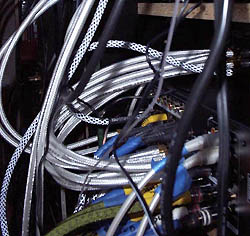
EMI can be caused by electromagnetic fields that can emit low frequencies. These fields can surround transformers, power lines and other devices that use or transport large amounts of electrical current. (It’s also often heard as hum or buzz.)
Three primary types of shielding are employed to combat these problems: braid, spiral and foil. In terms of cost, braid shielding is the most expensive, involving copper strands woven into a braided pattern around the center conductor’s inner jacket.
The braided approach works best with microphone cables because of their low inductance. (Inductance is the storage of magnetic energy. Magnetic energy is stored as long as current keeps flowing).
Spiral shielding is more flexible than braiding, and is commonly used in guitar cables. A drawback to spiral wrap is that, like a slinky in motion, one side compresses while the other separates. It’s through these separated strands that RFI can enter.
To compensate for the rejection loss of RFI, sometimes a secondary shield is added, using carbon as a semi-conductor. This is generally effective over very short distances.
The carbon is not a solid sheet, rather, microscopic bits of carbon mixed into another, more flexible material (usually a plastic composite). The bits of carbon conduct current from bit to bit.
Foil wrap shielding is the least expensive shielding method, and some provide full 100 percent coverage. It can be very effective against RFI.
A drain wire runs next to the foil, providing a way to terminate the foil at the connectors, and is a technique is most often used in the construction of snakes. (Note: The drain wire runs along the foil shield to provide a means to connect the foil shield to the connector. The drain wire itself doesn’t actually do much shielding at all.)
Journey’s End
It’s often true that the last thing on the system professionals mind is cable. After all, like roads and highways, they can be utilitarian by nature.
But as with roads and highways, making the right choices is the optimum way to get to your destination, which is good, clean optimized audio. All it takes is some attention to the basics combined with critical evaluation.
E. Victor Brown is a veteran pro audio writer. And special thanks to Cable Factory and Gotham Audio contributing to this article.
